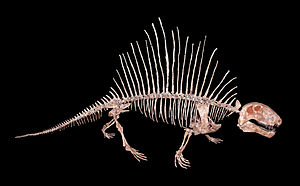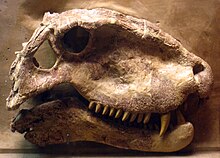Dimetrodon
| Dimetrodon | ||||||||||||
|---|---|---|---|---|---|---|---|---|---|---|---|---|

Skeleton assembly of D. incisivus in the State Museum for Natural History Karlsruhe |
||||||||||||
| Temporal occurrence | ||||||||||||
| Unterperm | ||||||||||||
| 300 to 272.5 million years | ||||||||||||
| Locations | ||||||||||||
| Systematics | ||||||||||||
|
||||||||||||
| Scientific name | ||||||||||||
| Dimetrodon | ||||||||||||
| Cope , 1878 | ||||||||||||
Dimetrodon ("two measures of teeth") is a genus of carnivorous pelycosaurs (Pelycosauria) of a paraphyletic taxon of extinct synapsids (formerly known as "mammal-like reptiles") from the early Permian . It is named after the presence of two differently shaped tooth types. The therapsids (Therapsida), from which the mammals (Mammalia) descended,emergedfrom the pelycosaurs. The American zoologist Edward Drinker Cope established the genus in 1878. Theanimal,including its tail, up to 3.5 meters long, lived in the Cisuralium (early Permian)around 299 to 272.5 million years ago.
description
Dimetrodon had a long tail, claws on its feet, moved on four legs ( quadruped ), and may have weighed about 250 kilograms. A striking feature was a large back sail, presumably covered with skin, formed from elongated spinous processes of the vertebrae of the trunk and cervical spine , which, according to older doctrine, probably served to regulate body temperature and was also formed in some other pelycosaurs, such as Edaphosaurus . In order to warm the body more quickly, Dimetrodon, according to this opinion , turned its flank towards the sun, which enabled the cold-blooded (poikilothermal) animal to become more active. To cool down, he aligned his body parallel to the incoming rays of the sun. Presumably it also served to attract partners.
Against this thesis speaks that Dimetrodon's close relative Sphenacodon did not develop a back sail, but only a low back crest, which was unsuitable for thermoregulation.
Fossils
Fossils of Dimetrodon have been in the US states Texas and Oklahoma as well as in Europe found. Well-preserved specimens of D. teutonis come from the Bromacker site in Thuringia. Bromacker is an important site for fossil land vertebrates (Tetrapoda) of the early Permian. In addition to Dimetrodon , very good fossils from Diadectes and Seymouria were also found here.
Described species
- D. angelensis Olson
- D. booneorum Romer, 1937
- D. dollovianus (Cope, 1888)
- D. gigas (Cope, 1878)
- D. gigashomogeneous case
- D. grandis (Case, 1907)
- D. incisivus Cope, 1878
- D. Kempae Romer, 1937
- D. limbatus Romer and Price, 1940
- D. longiramus Case, 1907
- D. loomisi Romer, 1937
- D. macrospondylus (Cope, 1885)
- D. milleri Romer, 1937
- D. natalis (Cope, 1878)
- D. obtusidens (Cope, 1880)
- D. occidentalis Berman, 1977
- D. platycentrus Case, 1907
- D. rectiformis Cope, 1878
- D. semiradicatus Cope, 1881
- D. teutonis Berman et al. , 2001
literature
- Robert L. Carroll : Vertebrate Paleontology and Evolution , WH Freeman & Co., New York 1988. ISBN 0-7167-1822-7
- Michael J. Benton : Paleontology of the vertebrates . Publishing house Dr. Friedrich Arrow. Munich, 2007 ISBN 3-89937-072-4
Web links
Individual evidence
- ^ ED Cope. 1878. "Descriptions of extinct Batrachia and Reptilia from the Permian formations of Texas." Proceedings of the American Philosophical Society 17: 505-530
- ↑ a b The Paleobiology Database . Last accessed on February 25, 2011
- ↑ Huttenlocker et al. (2010): Comparative Anatomy and Osteohistology of Hyperelongate Neural Spines in the Sphenacodontids Sphenacodon and Dimetrodon (Amniota: Synapsida), in: Journal of Morphology 271: 1407-1421, PMID 20886514 .
- ↑ Berman et al. (2001): A new species of Dimetrodon (Synapsida: Sphenacodontidae) from the Lower Permian of Germany records first occurrence of genus outside of North America. In: Can. J. Earth Sci. 38 , pp. 803-812.

